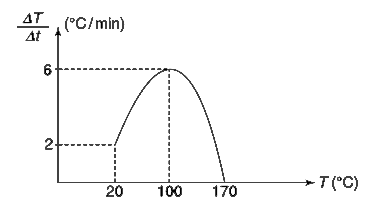Level 1 from ARIHANT PHYSICS (HINGLISH) CALORIMETRY for Class 11
| Class 11 | PHYSICS |
| Chapter | CALORIMETRY |
| ARIHANT PHYSICS (HINGLISH) | Level 1 |
| Medium | English |
| Academic Year | 2023-2024 |
Question 1
You are on a picnic and you make tea for yourself and your friend. However, your friend has gone out to bring something for you. You observed that the fire (that you ignited for making tea) has heated two nearby blocks of stones – one of sand stone and other of granite – to 90∘C. Both blocks have nearly same mass but granite has higher specific heat than marble. To keep the tea hot for your friend you decided to place the tea pot on one of the stones. Which stone will you choose – granite or marble? View SolutionQuestion 2
An electric kettle is filled with 1.3kg of water at 20∘C. The power of the heating coil of the kettle is 2.0 KW. After switching it on the water begins to boil in 220s . If the kettle was kept on for a further interval of Δt it was observed that only 200g water remained in the kettle and remaining water vaporized (the vapor is allowed to escape through a small vent). The specific latent heat of vaporization of water at 100∘C (boiling point) is L=2.26KJ/g. Calculate the specific heat capacity of water and the interval Δt. Assume that heat supplied by the heater is completely absorbed by the water. View SolutionQuestion 3
A heavy machine rejects a liquid at 60∘C which is to be cooled to 30∘C before it is fed back to the machine. The liquid rejected by the machine is kept flowing through a long tube while it is cooled by 60 liter water surrounding the tube. The initial temperature of the cooling water is 10∘C and it is 20∘C when it is changed after 1 hour. Calculate the amount of liquid that passes through the tube in one hour. Specific heat capacity of the liquid and water are 0.5calg−1.∘C−1 and 1.0calg−1.∘C−1 respectively. View SolutionQuestion 5
A certain mass of a solid exists at its melting temperature of 20∘C. When a heat Q is added 45 of the material melts. When an additional Q amount of heat is added the material transforms to its liquid state at 50∘C. Find the ratio of specific latent heat of fusion (in J/g) to the specific heat capacity of the liquid (in Jg−1.∘C−1) for the material. View SolutionQuestion 6
The temperature of samples of three liquids A, B and C are 12∘C, 19∘C and 28∘C respectively. The temperature when A and B are mixed is 16∘C and when B and C are mixed it is 23∘C.
(i) What should be the temperature when A and C are mixed?
(ii) What is final temperature if all the three liquids are mixed?
Assume no heat loss to the surrounding. View SolutionQuestion 7
A table top is made of aluminium and has a hole of diameter 2 cm. An iron sphere of diameter 2.004 m is resting on this hole. Below the hole, an insulated container has 2 kg of water in it. Everything is at ambient temperature of 25∘C. The table top along with the iron sphere is heated till the ball falls through the hole into the water. Find the equilibrium temperature of the ball and water system
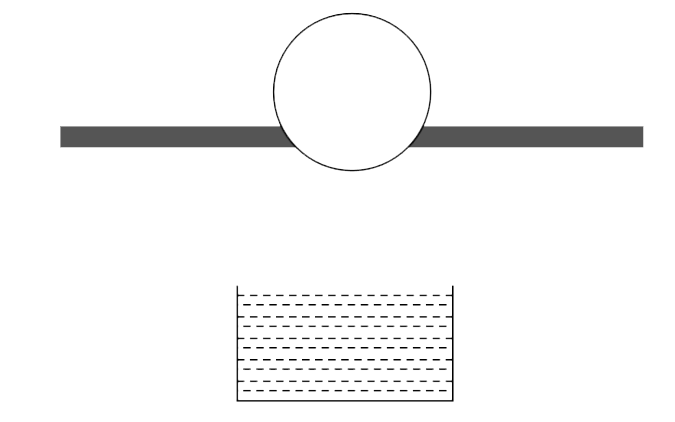
Neglect any heat loss from ball–water system to the surrounding and assume the heat capacity of the container to be negligible.
Relevant data: Coefficient of linear expansion for aluminium and iron are 2.4×10−5.∘C−1 and 1.2×10−5.∘C−1 respectively. Specific heat capacity of water and iron are 4200J.∘C−1g−1 and 450J.∘C−1g−1 respectively. Density of iron at 25∘C is 8000kg/m3. View SolutionQuestion 8
A 50 g ice at 0∘C is added to 200 g water at 70∘C taken in a flask. When the ice has melted completely, the temperature of the flask and the contents is reduced to 40∘C. Now to bring down the temperature of the contents to 20∘C, find a further amount of ice that is to be added. View SolutionQuestion 9
The latent heat of vaporization of water at its boiling point is LV. But water can evaporate at temperatures below the boiling point – for example it evaporates at body temperature when you perspire. Will the energy needed to evaporate unit mass of water at body temperature be more than or less than LV? View SolutionQuestion 10
A vessel contains a small amount of water at 0∘C. If the air in the vessel is rapidly pumped out, it causes freezing of the water. Why? What percentage of the water in the container can be frozen by this method? Latent heat of vaporization and fusion are LV=540calg−1 and Lf=80calg−1 respectively.View SolutionQuestion 11
A vessel containing 100 g ice at 0∘C is suspended in a room where temperature is 35∘C. It was found that the entire ice melted in 10 hour. Now the same vessel containing 100 g of water at 0∘C is suspended in the same room. How much time will it take for the temperature of water to rise to 0.5∘C. Neglect the heat capacity of the vessel. Specific heat of water and specific latent heat of fusion of ice are 1calg−1.∘C−1 and 80calg−1 respectively.View SolutionQuestion 12
A calorimeter of negligible heat capacity contains ice at 0∘C. 50 g metal at 100∘C is dropped in the calorimeter. When thermal equilibrium is attained the volume of the content of the calorimeter was found to reduce by 0.5×10−6m3. Calculate the specific heat capacity of the metal. Neglect the change in volume of the metal. Specific latent heat of fusion of ice is L=300×103Jkg−1 and its relative density is 0.9. View SolutionQuestion 13
A refrigerator converts 1.3 kg of water at 20∘C into ice at −15∘C in 1 hour. Calculate the effective power of the refrigerator. Specific latent heat of fusion of ice =3.4×105Jkg−1 Specific heat capacity of water =4.2×103Jkg−1K−1 Specific heat capacity of ice =2.1×103Jkg−1K−1 View SolutionQuestion 14
A calorimeter of water equivalent 10 g contains a liquid of mass 50 g at 40.∘C. When m gram of ice at −10∘C is put into the calorimeter and the mixture is allowed to attain equilibrium, the final temperature was found to be 20∘C. It is known that specific heat capacity of the liquid changes with temperature as S=(1+θ500)calg−1.∘C−1 where θ is temperature in .∘C. The specific heat capacity of ice, water and the calorimeter remains constant and values are Sice=0.5calg−1.∘C−1,Swater=1.0calg−1.∘C−1 and latent heat of fusion of ice is Lf=80calg−1. Assume no heat loss to the surrounding and calculate the value of m. View SolutionQuestion 15
A well insulated container has a mixture of ice and water, at 0∘C. The mixture is supplied heat at a constant rate of 420 watt by switching on an electric heater at time t = 0. The temperature of the mixture was recorded at time t = 150s, 273s and 378s and the readings were 0∘C, 10∘C and 20∘C respectively. Calculate the mass of water and ice in the mixture. Specific heat of water =4.2Jg−1.∘C−1, Specific latent heat of fusion of ice =336Jg−1. Assume that the mixture is stirred slowly to maintain a uniform temperature of its content. View SolutionQuestion 16
An insulated container has 60 g of ice at −10∘C. 10 g steam at 100∘C, sourced from a boiler, is mixed to the ice inside the container. When thermal equilibrium was attained, the entire content of the container was liquid water at 0∘C. Calculate the percentage of steam (in terms of mass) that was condensed before it was fed to the container of ice. Specific heat and latent heat values are
Sice=0.5calg−1.∘C−1, Swater=1.0calg−1.∘C−1
Lfusion=80calg−1, Lvaporization=540calg−1 View SolutionQuestion 17
A container contains 5 kg of water at 0∘C mixed to an unknown mass of ice in thermal equilibrium. The water equivalent of the container is 100 g. At time t = 0, a heater is switched on which supplies heat at a constant rate to the container. The temperature of the mixture is measured at various times and the result has been plotted in the given figure. Neglect any heat loss from the mixture – container system to the surrounding and calculate the initial mass of the ice.
Given: Sp. latent heat of fusion of ice is Lf=80calg−1
Sp. heat capacity of water =1calg−1.∘C−1
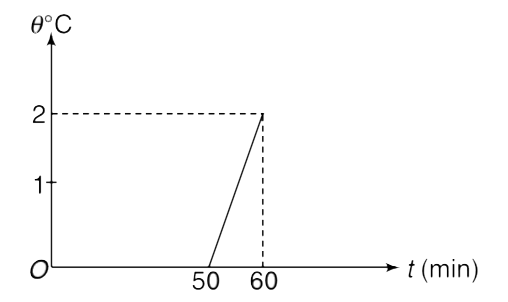 View Solution
View SolutionQuestion 19
A meteorite has mass of 500 kg and is composed of a metal. The temperature of the meteor is −20∘C and its speed is 10 km/hr when it is at large distance from a planet. The meteorite crashes into the planet and its entire kinetic energy gets converted into heat. This heat is equally shared between the planet and the meteorite. Assume that the heating of meteorite is uniform and the average specific heat capacity of the metal, for its solid, liquid and vapour phase, is 1200Jkg−1.∘C−1. The latent heat of fusion and vaporization of the metal are Lf=4×105Jkg−1 and Lv=1.1×107Jkg−1 respectively. The melting point and boiling points are 380.∘C and 2380.∘C respectively. Find the temperature of the meteorite material immediately after the impact.
Take: G=6.6×1011Nm2kg−2, mass of planet M=6×1024kg, radius of planet R = 6600 kmView SolutionQuestion 20
100 g of ice at −40∘C is supplied heat using a heater. The heater is switched on at time t = 0 and its power increases linearly for first 60 second and thereafter it becomes constant as shown in the graph. Heater is kept on for 5 minutes. The specific heat capacity for ice and water are known to be 2.1Jg∘C and 4.2Jg∘C respectively. The specific latent heat for fusion of ice is 336J/g.
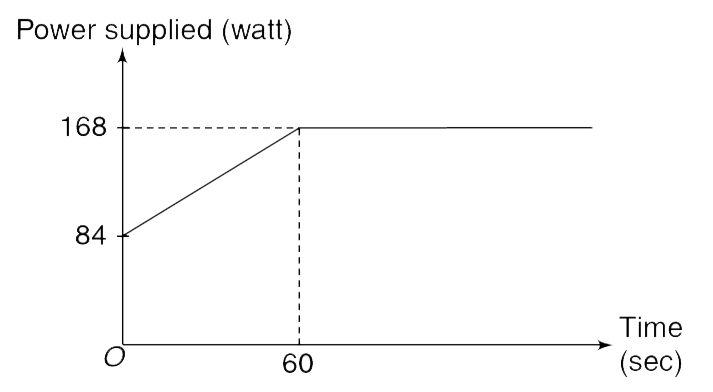
The temperature of the ice sample kept on increasing till time t1 and then remained constant in the interval t1<t<t2.
(i) Find t1 and t2
(ii) Find final temperature of the sample when the heater is switched off. View SolutionQuestion 21
A container has a square cross-section of 10cm×10cm. A cubical ice block of side length 6 cm is floating in water in the container. Water level in the container is 6 cm high. The ice block is at a temperature of 0∘C and the water is at 16.15∘C. Assume that heat exchange take place between the ice block and water only. What length of ice block will remain submerged in water when the system reaches thermal equilibrium? Assume that the ice block maintains its cubical shape as it melts. Take - density of ice =0.9g/cc, density of water = 1.0g/cc
Specific heat capacity of water =1calg−1.∘C−1, Specific latent heat of fusion of ice =80calg−1
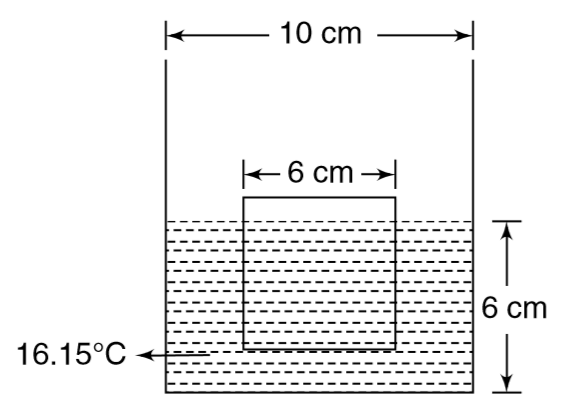 View Solution
View SolutionQuestion 22
Two identical cylindrical containers A and B are interconnected by a tube of negligible dimensions. Container A is filled with an ice block up to height H = 1.8 m and container B is filled up to same height with water. Ice is at 0∘C and water is at 40∘C. Due to heat exchange between water and ice, the ice block begins to melt. Assume that the ice block melt in horizontal layers starting from the bottom. The thickness of ice block reduces uniformly over the entire cross section of the container. The ice block moves without friction inside the container and no water enters between the vertical wall of the container and the ice block. Heat is exchanged only between the ice block and the water and there is no heat exchange with containers or atmosphere. Calculate the height of water in container B when thermal equilibrium is attained. Relative density and specific latent heat of fusion of ice are 0.9 and 80calg−1 respectively. Specific heat capacity of water is 1calg−1.∘C−1.
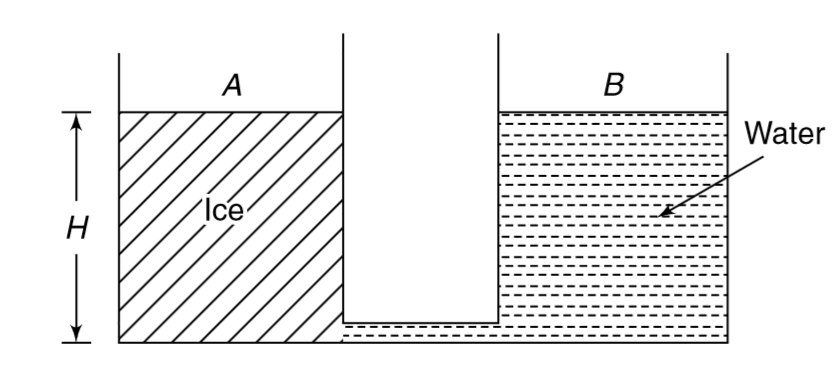 View Solution
View SolutionQuestion 23
A well insulated box has two compartments A and B with a conducting wall between them. 100 g of ice at 0∘C is kept in compartment A and 100 g of water at 100∘C is kept in B at time t = 0. The temperature of the two parts A and B is monitored and a graph is plotted for temperatures TA and TB versus time (t) [Fig. (b)]. Assume that temperature inside each compartment remains uniform.
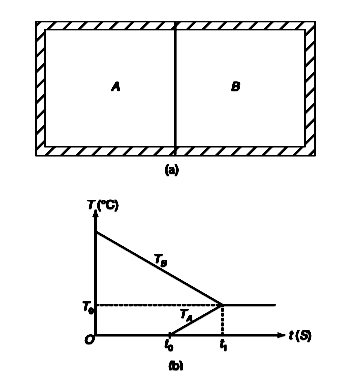
(a) Is it correct to assert that the conducting wall conducts heat at a uniform rate, irrespective of the temperature difference between A and B?
(b) Find the value of time t1 and temperature T0 shown in the graph, if it is known that t0=200s.
Specific heat of ice =0.5calg−1.∘C−1
Specific heat of water =1.0calg−1.∘C−1
Latent heat of fusion of ice =80calg−1 View SolutionQuestion 24
An ice ball has a metal piece embedded into it. The temperature of the ball is −θ∘C and it contains mass M of ice. When placed in a large tub containing water at 0∘C, it sinks. Assume that the water in immediate contact with the ice ball freezes and thereby size of the ball grows. What is the maximum possible mass of the metal piece so that the ball can eventually begin to float. Densities of ice, water and metal are σ,ρ and d respectively. Specific heat capacity of ice is s and its specific latent heat is L. Neglect the heat capacity of the metal piece.View SolutionQuestion 25
Water from a reservoir maintained at a constant temperature of 80∘C is added at a slow and steady rate of m =3gs−1 to a calorimeter initially containing 1000 g of water at 20∘C. The water in the calorimeter is stirred slowly to make the temperature uniform. Assume heat loss to the surrounding and work done in stirring is negligible and heat capacity of the calorimeter is negligible. Write the temperature of water in the calorimeter as a function of time. View SolutionQuestion 26
A cylindrical container has a cross sectional area of A0=1cm2 at 0∘C. A scale has been marked on vertical surface of the container which shows correct reading at 0∘C. A liquid is poured in the container. When the liquid and container is heated to 100∘C, the scale shows the height of the liquid as 83.33 cm. The coefficient of volume expansion for the liquid is γ=0.001∘C−1 and the coefficient of linear expansion of the material of cylindrical container is α=0.0005∘C−1. A beaker has 300cm3 of same liquid at 0∘C. The two liquids are mixed. Find the final temperature of the mixture assuming that heat exchange takes place between the liquids only, and its specific heat capacity is independent of temperatureView SolutionQuestion 27
A copper calorimeter has mass of 180 g and contains 450 g of water and 50 g of ice, all at 0∘C. Dry steam is passed into the calorimeter until a certain temperature (θ) is reached. The mass of the calorimeter and its contents at the end of the experiment increased by 25 g. Assume no heat loss to the surrounding and take specific heat capacities of water and copper to be 4200Jkg−1K−1 and 390Jkg−1K−1, respectively. Take specific latent heat of vaporization of water to be 3.36×105Jkg−1 and 2.26×106Jkg−1 respectively.
(a) Find the final temperature θ
(b) If steam enters into the system at a steady rate of 5g−1min, plot the variation of temperature of the system till final temperature θ is attained.View Solution
